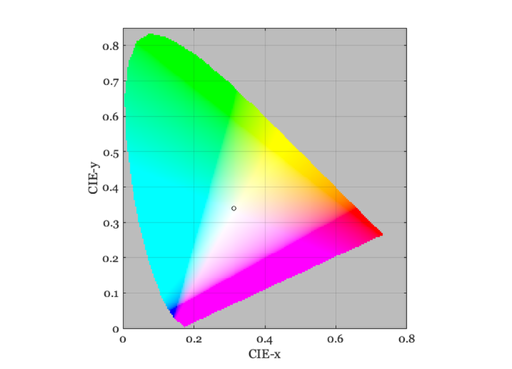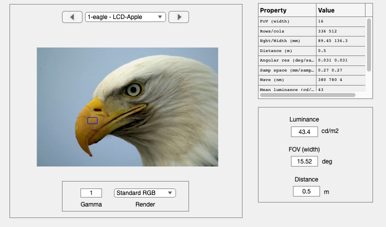Converting typical images to spectral radiance
RGB data can be converted to scene spectral radiance, making it possible to many different scenes. Of course, RGB data do not have full spectral information, so ISET must convert the RGB data into spectral radiance data based on some principles. The computation we use is performed by an algorithm called by sceneFroMFile within the functon vcReadImage.
Briefly, the algorithm is this:
1) We assume the RGB data will be displayed on a calibrated monitor with a known spectral power distribution. The user can specify the display, or a default is chosen.
2) The white (R=G=B at max) spectral power distribution of the display is set to be the scene illuminant.
If we make these assumptions, we can calculate reflectances of surfaces in the scene by dividing the scene radiance by the illuminant spd. These surface reflectances are plausible, as we discovered by many experiments. See the script s_sceneFromRGBvsMultispectral to evaluate how well this method does.
N.B. Once we have plausible scene reflectances we can render the scene under a different illuminant, say a daylight tungsten or many other examples.
See also: s_sceneFromMultispectral, sceneFromFile, displayCreate, ieXYZFromEnergy, chromaticityPlot, ieDrawShape
Copyright ImagEval, 2011
Contents
ieInit delay = 0.2;
Load display calibration data
displayCalFile = 'LCD-Apple.mat'; load(displayCalFile,'d'); dsp = d; wave = displayGet(dsp,'wave'); spd = displayGet(dsp,'spd'); ieNewGraphWin; plot(wave,spd); xlabel('Wave (nm)'); ylabel('Energy'); grid on title('Spectral Power Distribution of Display Color Primaries');

Analyze the display properties: Chromaticity
d = displayCreate(displayCalFile); whtSPD = displayGet(d,'white spd'); wave = displayGet(d,'wave'); whiteXYZ = ieXYZFromEnergy(whtSPD',wave); % Brings up the window fig = chromaticityPlot(chromaticity(whiteXYZ));

Read in an rgb file and create calibrated display values
rgbFile = fullfile(isetRootPath,'data','images','rgb','eagle.jpg'); scene = sceneFromFile(rgbFile,'rgb',[],displayCalFile); % Show the scene % sceneWindow(scene); pause(delay);
Change the illuminant to 6500 K
bb = blackbody(sceneGet(scene,'wave'),6500,'energy'); scene = sceneAdjustIlluminant(scene,bb); sceneWindow(scene); pause(delay); % Now the reflectances and the illuminant are plausible natural % measurements. Not great, but plausible. % Here is how I selected the rectangle % [~, rect] = ieROISelect(scene); % Here is the yellow beak region and its reflectance rect = [144 198 27 18]; r = ieDrawShape(scene,'rectangle',rect); set(r,'EdgeColor',[0 0 1]); scenePlot(scene,'reflectance roi',rect);

